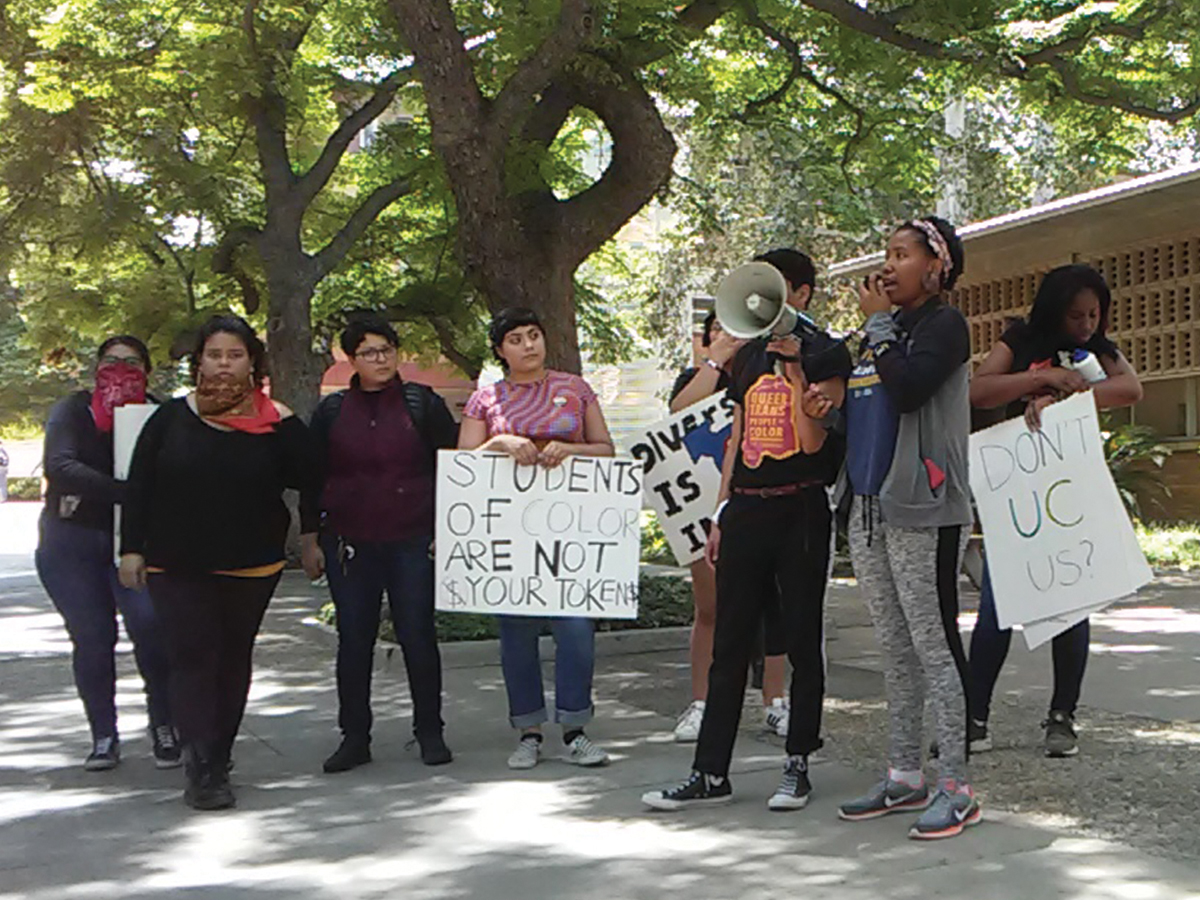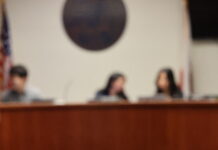Students gathered under the Bell Tower on Tuesday, May 29 to protest the disparity between the UCR administration’s salaries and the amount of money spent for the benefit of students, especially those of Costo Hall, as well as the lack of transparency in how the administration spends money. They also protested that the lack of student funding does not coincide the positive image of diversity that the university advertises.
The march was led by Melanie Yazzie, a professor of gender and sexuality studies, and organized by GS 107, “a coalition of students seeking justice for” student and workers’ rights. GS 107 also leads the R’Claim movement, which according to its Facebook page, is “a demonstration that brings together multiple issues across UCR.”
Yazzie also supplied a document titled “GS 107 Demands” that outlines the reasons for the march and the demands that the protesters hope will be met. The document states that if the demands it lists out are not met during the summer of 2018, GS 107 will “initiate a UC-wide campaign during the Fall 2018 quarter demanding the resignation of Chancellor Kim Wilcox and all top UCR administrators” and establish a student committee for Costo Hall in charge of selecting a replacement chancellor.
According to Yazzie, the march was intended to be a “starting point for galvanizing various communities within UCR to form a large and successful movement for student and worker rights,” as well as a way to bring the issues among those parties to light.
The march’s guest speakers began taking the microphone at 11:30 a.m. Anaf Wako, a member of GS 107, spoke about why the needs of African, Native American and Chicano Student Programs were “relegated to a ballot on the Highlander Referendum,” referring to the Highlander Empowerment Student Services Referendum, which would have supplied funds to those and other programs but failed to reach its voting quota in April. The “GS 107 Demands” list states that this “current process of referendum voting is unreliable.”
Wako also wondered why the staff involved with managing those programs were the most underfunded, referring to the $300,000 that Wilcox makes annually while “maintenance workers cannot even secure contracts to take care of their families.” Wako later stated that despite the lack of funding to student interests, the university still used the image of students to advertise the school in pamphlets and brochures, which Wako said was “tokenism at best and exploitation at worst.”
Cuauhtemoc Peranda was another guest speaker, a graduate student with a bachelor’s degree in Comparative Studies in Race and Ethnicity. He said that fellow graduate students did not receive any kind of funding from the administration and hoped that the march would help spark a movement to change that. The list of demands for GS 107 do not ask for any kind of assistance directed towards graduate students.
Graduate student Frank Perez took the microphone and spoke as “a working class student, a community college student, a community college educator, as a grad student and as a parent.” He commented on how he went into the Scotty store that day and saw the signs on the registers asking students to donate money for food-insecure students on campus. Perez saw this as “an expectation for students, rather than elected officials with bloated incomes, to support students.”
Perez went on to discuss how CHASS tuition subsidizes other colleges on campus in the form of grants rather than going to the faculty of CHASS and stated that the tuition should instead be funnelled in-house and that the administration ought to receive a pay cut that goes directly to helping the students, such as those that are food-insecure. The request for in-house tuition funneling is one of the stipulations in the GS 107 list of demands.
The last speaker of the march was David Chavez, a sixth-year doctoral candidate in the department of history and recording secretary for the UC Workers’ Union. He emphasized the importance of students having more control over the money they spend toward the university and mentioned that in 1968, students “occupied and liberated the San Francisco State University through the Third World Liberation Strike” under similar demands that the students of the march that day were protesting for. He also called for “an end to white supremacy, sexual harassment and sexual violence on campus and throughout the UC system” and wanted UCR to be a sanctuary campus for undocumented and international students that gives both those groups free tuition.
An unnamed spectator proceeded to take the microphone that claimed to be a veteran of the 1968 San Francisco strike that Chavez spoke about. He affirmed that the strike was done in part for ethnic studies alongside the Latin American Student Organization and multiple Mexican organizations. He voiced his support for what the marchers were doing because he considered himself a “community person and a community representative.”
Yazzie then took the microphone to ask why there weren’t more faculty in the audience, specifically those that had tenure. Being a lecturer at UCR, Yazzie did not have tenure and was therefore putting her career at risk by being at the march. She stressed that faculty needed to attend more events such as this march to show that they cared about the students and their needs.
The marchers then gathered in a circle and proclaimed the Assata Shakur chant before beginning the march at 12:15 p.m. Assata Shakur was a member of the Black Liberation Army, a black nationalist group, and created the chant to inspire activists to fight against discrimination together. They marched in front of Pierce Hall and headed left, down and through the HUB food court, continuing past Costo Hall and the Student Services building. They then marched toward and up the stairs of Hinderaker Hall, where UCR’s administration offices are housed.
Outside his fourth floor office, Wilcox came out to receive a list of demands from the demonstrators and to listen to what each march member had to say.
Victor Marroquin, a third-year gender and sexuality studies major, began by expressing his concerns about food insecurity on campus and the lack of funding towards Costo Hall, its programs, and ethnic studies. Wilcox thanked everyone in the hall for the feedback on what needed to be done and said that he would hold a discussion in the HUB at 10 a.m. on Thursday that same week to further talk things out.
Marroquin confirmed that the marchers would attend the meeting, but emphasized that “this (march) is an accumulation of anger for years. We’re protesting not just because of the Highlander Empowerment Referendum, but because of our campus experience ever since we came here,” Marroquin said, referring to the directing of funds towards infrastructure rather than students. “I’ve seen new buildings go up, but the issues I had ever since I first came here are still here.”
Protesters continued to echo the issues that were voiced under the Bell Tower and then walked back downstairs to the front of Hinderaker Hall, gathering in a circle and expressing their gratitude for being able to participate in the march and having their voice be heard. The march concluded with a Unity Clap, a symbol of solidarity created by the United Farm Workers labor union representing Latinos and Filipino laborers.
Yazzie considered the march a success, explaining that “students (at the march) clearly felt empowered to voice their outrage at the injustice they experience here at UCR.” GS 107 is now working toward an agreement between Wilcox and the rest of UCR’s administration on how the school’s financial budget ought to be handled.








